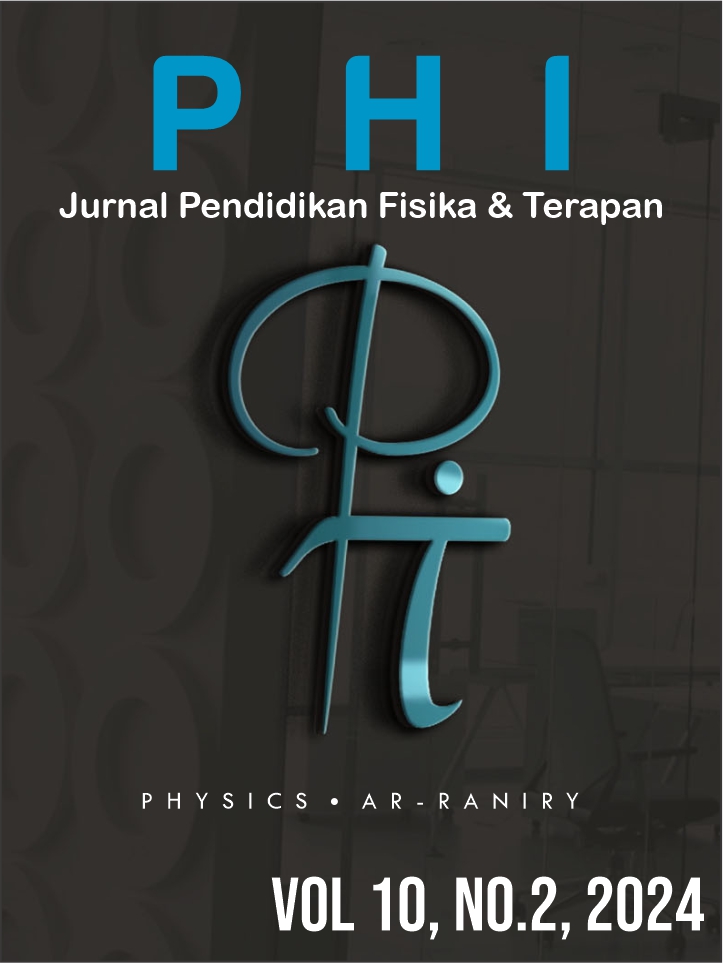The Development of Snakes and Ladders Game-Based Learning Media on the Topic of Vibrations and Waves Using Google Slides for Junior High School Students
DOI:
https://doi.org/10.22373/p-jpft.v10i2.24132Keywords:
Learning Media, Google Slide, Snakes and Ladders Game, Vibrations and WavesAbstract
The topic of Vibrations and waves is considered challenging for students. The subject must be delivered with good strategies and supported by good learning media. The purpose of this study is to develop an alternative learning media based on the classic Snakes and Ladders game using Google Slides for the topic of Vibrations and Waves at the junior high school level. The development steps of the media were adapted from the design model of Alessi and Trollip, which consists of three stages, including (1) planning, (2) design, and (3) development. In the development phase, six reviewers participated in the product evaluation. Three of them are as media experts and the others are as material experts. After evaluating the product, reviewers provided remarks and scores for each evaluation aspect. Overall, the product received an 86.87% score for the media aspect and a 92.06% score for the material aspect, both categorized as very feasible. These results indicate that the Snakes and Ladders game-based learning media on the topic of Vibrations and Waves using Google Slides is very feasible for use in the teaching and learning process for junior high school students.References
Angell, C., Guttersrud, O., Henriksen, E.K., Isnes, A. 2004. Physics: Frightful, But Fun. Pupils’ and Teacher’ Views of Physics and Physics Teaching. university of Oslo
Ekici, E. 2016. “Why Do I Slog Through the Physics?” Understanding High School Students’ Difficulties in Learning Physics. Journal of Education and Practice, Vol.7, No.7.
Erinosho, S. Y. (2013). How do students perceive the difficulty of physics in secondary school? An exploratory study in Nigeria. International Journal of cross disciplinary Subjects in Education (IJCDSE) Special Issue, 3(3), 1510-1515.
Fitriana, N.S. 2008. Pengembangan Media Permainan Ular Tangga Terintergrasi Asmaul Husna Pada Pembelajaran Tematik. Skripsi. Universitas Islam Negeri Raden Intan. Lampung.
Musliman, A., & Kasman, U. 2022. Efektivitas Model Inkuiri Terbimbing untuk Melatih Kemampuan Berpikir Kritis Siswa Pada Konsep Fisika yang Bersifat Abstrak. Jurnal Jendela Pendidikan, Vol 02 (01), 48-53.
Novitasari, E., Suporwoko, Surantoro. 2013. Pengembangan Media Pembelajaran Berbasis IT Berbentuk Permainan Ular Tangga Materi Alat Optik Untuk Kelas VII SMP. Jurnal Pendidikan Fisika. Vol. 1 No. 1. hal.37-43
Oktaviara, R.A., and Pahlevi, T. 2019. Pengembangan E- Modul Berbantuan Kvisoft Flipbook Maker Berbasis Pendekatan Saintifik pada Materi Menerapkan Pengoperasian Aplikasi Pengolah Kata Kelas X OTKP 3 SMKN 2 Blitar. Jurnal Pendidikan Administrasi dan Perkantoran. Vol. 7 No. 3. hal. 63
Stefany, E.M. 2015. Respon Siswa pada Pengembangan Media Pembelajaran: Implementasi pada Mata Pelajaran TIK Kelas VIII di SMPN 4 Denpasar. Jurnal Ilmiah Eductic, Vol.2 No.2. hal.3.
Sugiono. 2019. Metode Penelitian dan Pengembangan (R&D). Bandung: ALFABETA.
Syifa Jamilah Purnama, S.J., Pramudiani, P. 2021. Pengembangan Media Pembelajaran Interaktif Berbasi Google Slide pada Materi Pecahan Sederhana di Sekolah Dasar. Jurnal Basicedu. Vol. 5 No.4. hal.2440-2448
Tanzeh, A. 2009. Pengantar Metode Penelitian. Yogyakarta: Teras.
Usep Kustiawan. 2016. Pengembangan Media Pembelajaran Anak Usia Dini. Malang: Penerbit Gunung Samudra
Wangchuk, D., Wangdi, D., Tshomo, S., & Zangmo., J. (2023). Exploring Students' Perceived Difficulties of Learning Physics. Educational Innovation and Practice. 6. https://doi.org/10.17102/eip.6.2023.03
Downloads
Published
Issue
Section
License
Authors who publish with Jurnal Phi agree to the following terms:
- Authors retain copyright and grant the journal right of first publication with the work simultaneously licensed under a Creative Commons Attribution License (CC BY 4.0) that allows others to share the work with an acknowledgment of the work's authorship and initial publication in this journal.
- Authors are able to enter into separate, additional contractual arrangements for the non-exclusive distribution of the journal's published version of the work (e.g., post it to an institutional repository or publish it in a book), with an acknowledgment of its initial publication in this journal.
- Authors are permitted and encouraged to post their work online (e.g., in institutional repositories or on their website) prior to and during the submission process, as it can lead to productive exchanges, as well as earlier and greater citation of published work (See The Effect of Open Access).

















